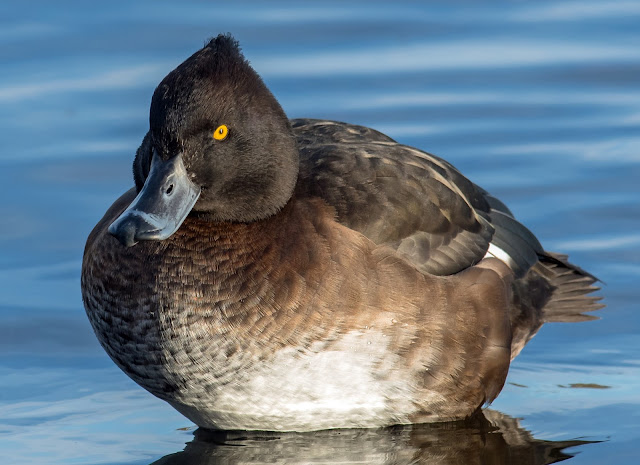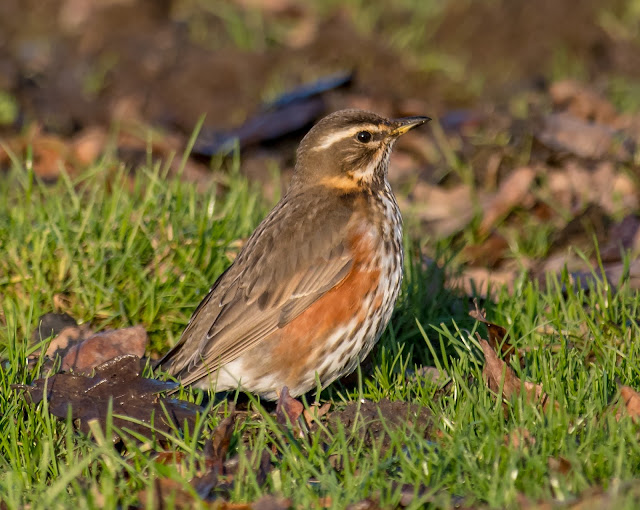With the prospect of seeing some Bearded Tits without legs rings, I set off for a quick trip to Fleetwood Marshes this afternoon. This is a new site for me and so I asked for instructions from Leonard Poxon, whose photos I'd seen on Facebook recently.
Armed with my new satnav, a birthday present from my wife last week, I set off on a cold and windy but very sunny afternoon. I found the location without any difficulty thanks to Leonard's excellent instructions and I was soon on the bridge overlooking the golden reed bed that he had described in his post. I waited over an hour without seeing them before deciding to have a walk down to the river Wyre estuary.
There was nothing much there either and the going was quite tough across the marsh so I soon head back to the reed bed. Another hour and no definite sightings of Bearded Tits. A few Reed Buntings came and went but even those were impossible to photograph as they quickly descended into the reeds as soon as they had landed.
I did think that I might not even get my camera out, but on walk around the small lake I cam across this female Tufted Duck which looked so beautiful in the golden afternoon light - I just had to take a picture! And so I spent the next hour taking photos of common and garden wildfowl and a few Gulls, whilst frequently checking the reeds for the Beardies, but with no luck today,
Friday, 13 January 2017
Thursday, 12 January 2017
Full Moon Over Tyldesley
I got one shot at tonight's full moon before it was covered in clouds. When the sun, moon and earth all line up at full moon then we get the highest (and indeed lowest) tides which are called 'spring' tides (nothing to do with the time of year!). In fact it takes a bit of time for the enormous mass of water to move, so the spring tide will actually occur a couple of days after the full moon.
Birders are always very keen to know about the current phase of the moon, because some of the best shoreline birding is done on high tides because they force wading and other birds to roost closer to the land. Where there are salt marshes, the land creatures that inhabit them are also forced to move further inland and this can often produce the spectacles of raptors and owls hunting and catching them with views much closer than normal.
Birders are always very keen to know about the current phase of the moon, because some of the best shoreline birding is done on high tides because they force wading and other birds to roost closer to the land. Where there are salt marshes, the land creatures that inhabit them are also forced to move further inland and this can often produce the spectacles of raptors and owls hunting and catching them with views much closer than normal.
Wednesday, 11 January 2017
Moonburst Over Astley Green Colliery
Although this blog is mainly about birds and birding, I do occasionally include landscape photographs and indeed, I am hoping to do more of this in the future. With the prospect of clear skies and a bright moon, I went down to Astley Green Colliery this evening to take a shot I've been thinking of for a while.
Ashley Green Colliery is now a coal-mining museum and I believe the pit head winding gear is the last one still standing in the whole of this region and, as such, it is quite an iconic structure around these parts.
My aim was to take a photograph of the moon with the colliery pit head gear in the foreground and it has to be said that I didn't realise how difficult this was going be in terms of exposure. I've taken photos of the moon before with decent results, but trying to include some detail in the foreground objects proved to be very challenging. Either the moon was too bright or the pit head too dark.
After several attempts with different settings, it became clear that I wasn't going to be able to get the shot I wanted tonight. In the end I had to opt for an atmospheric shot with the moon having a starburst effect. I now think the only way of pulling the shot is to bracket a number of exposures and combine them together using software.
Labels:
Astley Green Colliery,
Moon,
moonburst
Thursday, 5 January 2017
Let It Snow, Let It Snow, Let It Snow - Buntings
Having gone out to North Wales for the Crossbills this morning (see previous post), I decided to spend the afternoon with the three long-staying and very approachable Snow Buntings on the West Shore at Llandudno. The internet has been swamped with photos of these birds recently and as I've photographed Snow Buntings before, I wasn't unduly worried about seeing them. But as I was so close today, it seemed rude not to.
Labels:
Llandudno,
Snow Bunting
Crossbills in North Wales
Freezing cold temperatures and a sunny blue sky meant that I just had to go birding today and Crossbills were to be the main target bird. So I set the alarm for 7:00am and it was off to an undisclosed location in North Wales at the crack of 9:30am.
The male birds are a stunning red-orange colour and the females are a more drab yellowy-grey. But both have these extraordinary and very distinctive bills with crossed mandibles which are specially adapted for extracting the seeds from conifer pine cones.

The male birds are a stunning red-orange colour and the females are a more drab yellowy-grey. But both have these extraordinary and very distinctive bills with crossed mandibles which are specially adapted for extracting the seeds from conifer pine cones.

Labels:
Crossbill
Monday, 2 January 2017
A Mega Lifer to start the New Year
Third time lucky in Beeley, near Chatsworth in Derbyshire today. After two previously unsuccessful trips before Christmas, I finally connected with the female Dusky Thrush today. My views were distant and hence the photos are all record shots, but I had great scope views and the light was fantastic in the early afternoon. It was amazing how quickly the sun went down though, almost between shots!
This is only the 13th record of a Dusky Thrush in the UK since records began, but there have probably been a lot more of them about as they are easily mistaken for Redwings.
This bird seemed to be a loner most of the time, although a few Redwings were never far away. Indeed, I saw it chasing them off on more than one occasion.
These two blurred shots are best viewed small !
Finally, a couple of decent shots of the two other birds in the same area today:
Not a bad start to the New Year's birding.
This is only the 13th record of a Dusky Thrush in the UK since records began, but there have probably been a lot more of them about as they are easily mistaken for Redwings.
This little beauty has probably been blown in by the autumn's strong easterly gales which have provided us with such an amazing collection of rare birds this year.
It was probably heading south for warmer climes from its breeding grounds in chilly Siberia looking for more food sources when it was blown off course by strong winds.
This bird seemed to be a loner most of the time, although a few Redwings were never far away. Indeed, I saw it chasing them off on more than one occasion.
These shots were taken earlier in the afternoon when the light was much better but I wasn't quite as close. The bird was pretty faithful to a patch of grass in front off the tallest Ash tree in one of the hedgerows off Pig Lane.
These two blurred shots are best viewed small !
Finally, a couple of decent shots of the two other birds in the same area today:
Not a bad start to the New Year's birding.
Labels:
Dusky Thrush,
Redwing,
Robin
Subscribe to:
Comments (Atom)


































